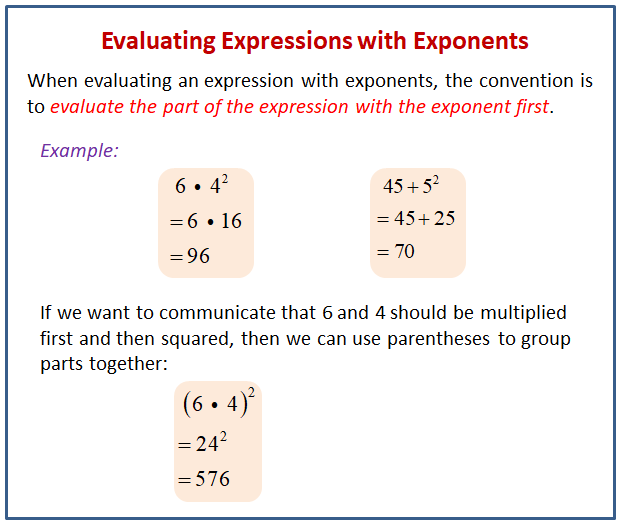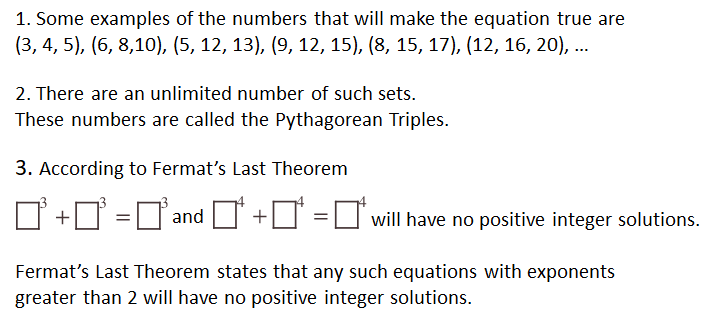Illustrative Mathematics Unit 6.6, Lesson 14: Expressions with Exponents
Learning Targets:
- I know how to evaluate expressions that have both an exponent and addition or subtraction.
- I know how to evaluate expressions that have both an exponent and multiplication or division.
Related Pages
Illustrative Math
Grade 6
Lesson 14: Evaluating Expressions with Exponents
Let’s find the values of expressions with exponents.
Illustrative Math Unit 6.6, Lesson 14 (printable worksheets)
Lesson 14 Summary
Exponents give us a new way to describe operations with numbers, so we need to understand how exponents get along with the other operations we know.
When we write 6 · 42, we want to make sure everyone agrees about how to evaluate this. Otherwise some people might multiply first and others compute the exponent first, and different people would get different values for the same expression!
Earlier we saw situations in which 6 · 42 represented the surface area of a cube with side length 4 units. When computing the surface area, we evaluate 42 first (or find the area of one face of the cube first) and then multiply the result by 6. In many other expressions that use exponents, the part with an exponent is intended to be evaluated first.
The following diagram gives some examples of evaluating expressions with exponents.

Lesson 14.1 Revisiting the Cube
Based on the given information, what other measurements of the square and cube could we find?
See Applet
Scroll down the page for the solutions to the “Are you ready for more?” section.
Lesson 14.2 Calculating Surface Area
A cube has side length 10 inches. Jada says the surface area of the cube is 600 in2, and Noah says the surface area of the cube is 3,600 in2. Here is how each of them reasoned:
Jada’s Method:
6 · 102
6 · 100
600
Noah’s Method:
6 · 102
602
3,600
Do you agree with either of them? Explain your reasoning.
Lesson 14.3 Expression Explosion
Evaluate the expressions in one of the columns. Your partner will work on the other column. Check with your partner after you finish each row. Your answers in each row should be the same. If your answers aren’t the same, work together to find the error.
Are you ready for more?
Consider this equation: ⃞2 + ⃞2 = ⃞2. An example of 3 different whole numbers that could go in the boxes are 3, 4, and 5, since
32 + 42 = 52
(That is, 9 + 16 = 25). Can you find a different set of 3 different whole numbers that make the equation true?
2. How many sets of 3 different whole numbers can you find?
3. Can you find a set of 3 different whole numbers that make this equation true?
⃞3 + ⃞3 = ⃞3
4. How about this one?
⃞4 + ⃞4 = ⃞4
5. Once you have worked on this a little while, you can understand a problem that is famous in the history of math. (Alas, this space is too small to contain it.) If you are interested, consider doing some further research on Fermat’s Last Theorem.
Lesson 14 Practice Problems
- Lin says, “I took the number 8, and then multiplied it by the square of 3.” Select all expressions that equal Lin’s answer.
A. 8 · 32
B. (8 · 3)2
C. 8 · 23
D. 32 · 8
E. 242
F. 72 - Evaluate each expression.
a. 7 + 23
b. 9 · 31
c. 20 - 24
d. 2 · 62
e. 8 · (½)2
f. ⅓ · 33
g. (⅕ · 5)5 - Andre says, “I multiplied 4 by 5, then cubed the result.” Select all expressions that equal Andre’s answer.
A. 4 · 53
B. (4 · 5)3
C. (4 · 5)2
D. 54 · 4
E. 203
F. 500
G. 8,000 - Han has 10 cubes, each 5 inches on a side.
a. Find the total volume of Han’s cubes. Express your answer as an expression using an exponent.
b. Find the total surface area of Han’s cubes. Express your answer as an expression using an exponent. - Priya says that ⅓ · ⅓ · ⅓ · ⅓ = 4/3 . Do you agree with Priya? Explain or show your reasoning.
- Answer each question. Show your reasoning.
a. 125% of e is 30. What is e?
b. 35% of f is 14. What is f? - Which expressions are solutions to the equation 1.4y = 13.75? Select all that apply.
A. 13.75 - 1.4
B. 13.75 · 2.4
C. 13.75 ÷ 2.4
D. 13.75/2.4
E. 2.4 ÷ 13.75 - Jada explains how she finds 15 · 23:
“I know that ten 23s is 230, so five 23s will be half of 230, which is 115. 15 is 10 plus 5, so is 230 plus 115, which is 345.”
a. Do you agree with Jada? Explain.
b. Draw a 15 by 23 rectangle. Partition the rectangle into two rectangles and label them to show Jada’s reasoning.
The Open Up Resources math curriculum is free to download from the Open Up Resources website and is also available from Illustrative Mathematics.
Try out our new and fun Fraction Concoction Game.
Add and subtract fractions to make exciting fraction concoctions following a recipe. There are four levels of difficulty: Easy, medium, hard and insane. Practice the basics of fraction addition and subtraction or challenge yourself with the insane level.

We welcome your feedback, comments and questions about this site or page. Please submit your feedback or enquiries via our Feedback page.
